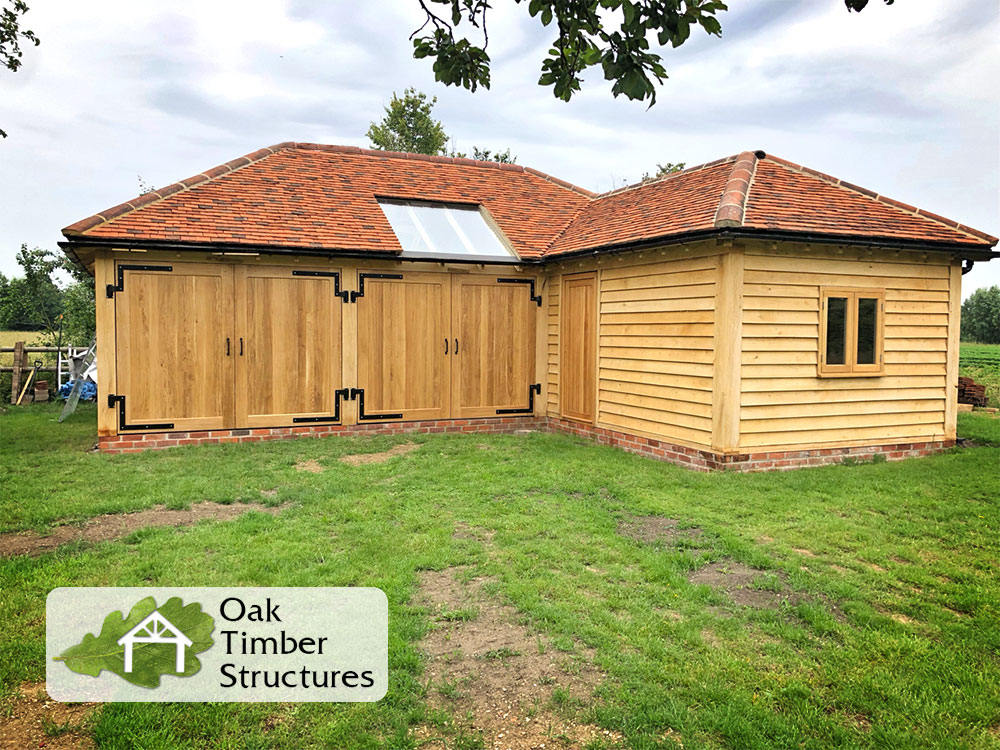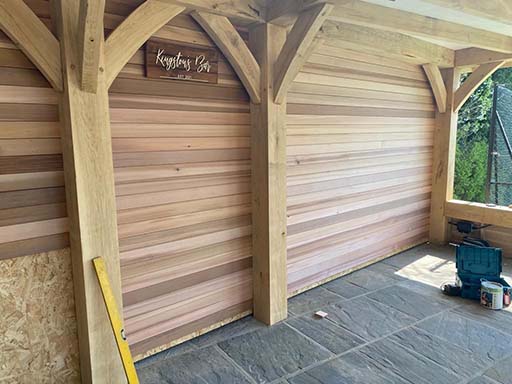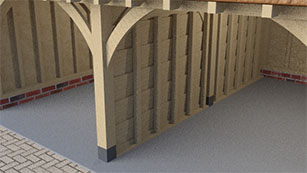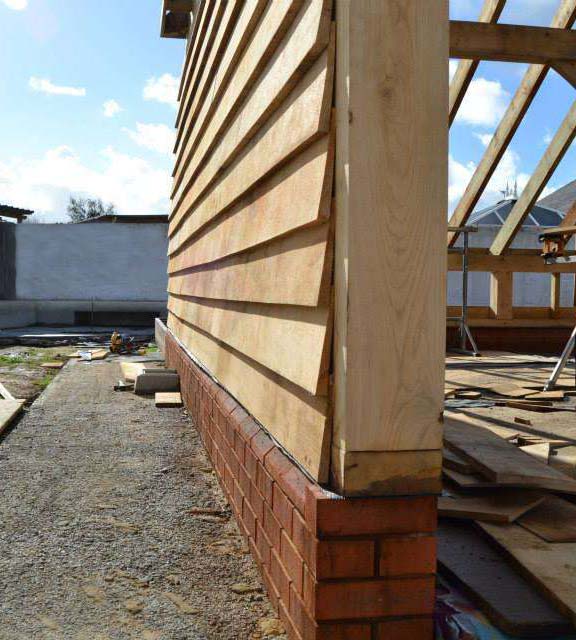
Contact us 01889 597 283 | contact@oaktimberstructures.co.uk
Contact us 01889 597 283 | contact@oaktimberstructures.co.uk

When buying from Oak Timber Structures, certain structures such as offices and garages allow you to add cladding.
Not considered cladding? What even is cladding?! Fear not, you'll learn the key information in this article.
But first...
What Cladding Is Best For An Oak Structure?
You can't beat cladding made from timber. More specifically, European Oak. Oak not only looks stunning, but it has a long lifespan. Cedar is another  sound choice. Western Red Cedar is a premium softwood with an impressive lifespan and striking red-tinged appearance. But Western Red Cedar is more expensive, so all things considered European Oak is the leading cladding material.
sound choice. Western Red Cedar is a premium softwood with an impressive lifespan and striking red-tinged appearance. But Western Red Cedar is more expensive, so all things considered European Oak is the leading cladding material.
While you may think the outer layer is a low priority, cladding can improve the performance of your structure and change the whole aesthetic.
Here’s everything you need to know.
Cladding is a protective layer fixed to the exterior of a building, in our case, an oak structure such as a gazebo, office, or garage. We often think of cladding as an outer skin to the structure. You can find cladding in a variety of materials, everything from UPVC, metal, and, of course, timber.
Why install cladding? After all, it's not mandatory. Cladding a structure has many benefits, so let's look at why cladding is so popular.
Cladding improves the aesthetic appeal of a structure. That applies to most buildings as you can add cladding to existing foundations. Have you seen the gigantic high-rise office buildings given a new lease of life? That was most likely fresh cladding.
Fitting an office with timber cladding, as opposed to glass, for example, improves privacy. What about a gazebo? A gazebo is open-sided as standard. At Oak Timber Structures, we like to give you choices, and you can add cladding to however many sides you want. So by adding cladding to even one side, the gazebo becomes more secluded.
One of the main functional aspects of cladding is to protect the internal structure from the elements. Cladding an oak garage or office offers an extra line of defence. Naturally, cladding one or more sides of a gazebo improves shelter from the wind. But it can also work alongside the roof to add further protection from sunlight. Not to mention, it’ll shield the main frame from rainfall.
Insulating behind cladding has become a popular choice for homeowners, especially because of the sharp rise in energy costs. It helps to keep the structure warm in winter and cool in summer. It can also help to reduce the amount of noise coming from outside, which is essential to create a tranquil space to focus on work or relax.
So you may now think that cladding sounds like a great idea! But why pick timber?
Let's not generalise, because plenty depends on the quality of timber. For example, if you clad your structure with planks of cheap wood, chances are it won't last too long.
But we only use the highest-grade timbers. So when adding our cladding to your structure, you can rest assured there's a healthy lifespan.
Let's face it, UPVC and metal cladding don't cut it. When compared to timber cladding, there's no contest. Timber cladding has a traditional aesthetic that's inviting to the eye. Compared to cheap artificial materials, timber always wins.
Timber also stands the test of time. Over many centuries, you'll find timber cladding and decoration. It's not a fad; to this day, we use timber cladding on both old and contemporary buildings.
By now you might be thinking, it all sounds great but is timber cladding durable in comparison? Well, Oak for example is very robust and will resist scuffs and marks far better than plastic alternatives, not to mention when it does get marked you can always sand it back like new whereas you’ll always have a telltale mark leftover on metal cladding.
As a water repellent, oak and cedar, by their very nature, are waterproof. Hence the reason oak has been a popular boat-making material for centuries.
But still, you can treat timber cladding boards to improve their performance and improve lifespan. For example, Osmo UV-Protection Oil protects from the sun's UV rays while reducing swelling and shrinkage.

Not to mention, plastic-based cladding can not only appear cheap, but UPVC isn't fire-resistant. Surprising, but timber can be fire treated. While we only supply the raw timber, we can direct you to the right company to make your timber fire resistant.
Another great benefit of timber is that it's an environmentally friendly material. Furthermore, we source our timber from sustainable European forests following excellent harvesting practices. As a result, our timber is significantly more eco-friendly. Especially compared to UPVC, which isn’t biodegradable.
Are you convinced timber is the right choice? We're not done yet. You've still got to pick the type of timber.
There are many we offer, but the most popular are European Oak, British Cedar, Western Red Cedar, and British Larch.
So which one do you pick? All timbers have unique characteristics and here's a good starting point to help make your decision. Cladding is a prominent feature and has a tremendous impact on the overall aesthetics of a structure. So let's look.
All timber develops a silver hue over time that's caused by exposure to the sun's UV rays. This aged character is desirable for many. That said, you can delay the silvering process with treatment.
Timbers with reduced knots such as European Oak and West Red Cedar deliver a clean aesthetic. British Cedar and British Larch have more knots, for some, this could add to the character and rustic aesthetic.
Not only do each species own unique visual characteristics, but likewise, there are varying levels of durability.
All timbers have a durability rating. European Oak and Western Red Cedar are in Class 2, so we regard them as durable. This means there’s a longer lifespan and cladding made from these can last up to 50 years in the best conditions. On average they will last between 15-25 years according to TRADA.
British Cedar and British Larch fall into the category below. These are Class 3 timbers and we consider them as 'Moderately Durable'. While less durable than European Oak and Western Red Cedar, they're still strong. And remember, you can always extend the lifespan with maintenance.
Price is a defining factor. So what's the score?
The most expensive is Western Red Cedar. Many things affect the price, an example being the availability or lack of, which can alter the price of any timber cladding. Not forgetting, Western Red Cedar is a premium timber, and as such, costs more.
European Oak is another high-quality timber but is more affordable than Western Red Cedar as it's easier to source and bring into the UK. It's also more durable and robust than Western Red Cedar yet boasts a lower price making it a sound choice. The main benefit of Western Red Cedar over Oak is the unique aesthetic and low knot content producing a contemporary finish.
The transportation costs of the British Larch and British Cedar make it more affordable. So if you want a more cost-effective timber cladding solution, these timbers are easy on the pocket but still look exquisite and serve to protect the main frame. Although, cladding made from these timbers won’t last as long as European Oak or Western Red Cedar cladding. Likewise, the additional knot content allows for an easier and more cost-effective selection process.
Installing cladding depends on the type. For oak structures, there are two main types of cladding.

First, tongue and groove, that slot together like a floorboard. You'll then fix them to the provided studwork and main frame. This creates a uniform aesthetic and can either run horizontal or vertical.
The other is feather edge cladding and we mostly use it for larger builds such as garages. These wedge-shaped boards direct rainfall away from the structure.
This is less straightforward to install as it is designed with an overlap of 20%. So, for a standard 190mm board, you’ll need a 38mm overlap. These fix to the supplied upright studwork.
When nailing cladding, consider the material of the nail. This will depend on the type of timber. For example, iron nails react with the tannins in oak that'll erode those nails. So stainless steel fixings are required instead.
The purpose of cladding is to further protect an oak structure from weathering and deterioration. Timber is excellent at this task regardless of the species.
But, certain timbers are better than others.
So what are the best cladding timbers? That’ll be Western Red Cedar and European Oak. Both have attractive looks, high durability, and a lifespan to last decades.
Oak is more traditional with a strong grain pattern. Whereas Western Red Cedar, with red and purple hues, is striking. But, here’s the thing, Western Red Cedar is very expensive.
So, weighing up the pros and cons, European Oak takes the prize as the best timber for cladding. It ticks all the boxes.
Oak is durable, waterproof, rot-resistant, and pleasing to the eye. Best of all, more affordable than Western Red Cedar. When buying an Oak Timber Structure, oak cladding adds cohesion to the frame creating an awe-inspiring construction of grandeur.
Of course, there are cheaper options. For example, if you want the reddish colour of cedar, opt for British Cedar. Albeit the reds are much less prominent, the colours are similar. But remember, it won’t have the same durability.
One thing is for sure, timber is the best cladding material. It boasts timeless looks that UPVC could never imitate.
We hope you now know more about cladding. Anything you're unsure of, contact our helpful staff, who'd be happy to help.